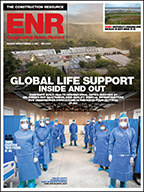The theme may have been "Imagining Construction's Future" at ENR's Nov. 7 FutureTech conference in New York City, but, for many panelists and attendees, what once seemed like tomorrow's technology is used on many projects today—and driving innovation.
"It's a fascinating time to be in our industry," said Matt Harris, a senior vice president with Viewpoint Software. "It's astonishing how cheap and scalable things are becoming, from a cloud [computing] environment." Although it's early in the era of mobility in construction, many firms are looking at real-time sensing data in the field and leveraging collaboration.
Those benefits come from not only documents and metadata "but with the models themselves," Harris added. "The capabilities are in place, and the economics are in place. It's cheaper than ever to do this stuff, and the systems are there."
One of the hottest things in construction is predictive analytics, said Dan Kieny, director of consulting and knowledge with MWH Global. During a panel discussion about big-data tools and the use of analytics, Kieny showed how the firm uses its own project and field data to create products and templates that provide knowledge to clients as well as to manage risk and make better investments. But with the latest generation of analytics tools, "you have to know the business problem you're going to solve," he added. "Engineers and builders have to envision new revenue streams using data because data will be the currency of the future."
During a panel discussion about the use of geographic information systems (GIS) tools on the I-5 Skagit River bridge repair project in Washington state, Jay Mezher, national director of virtual design and construction at Parsons Brinckerhoff, showed how his firm used point-cloud data to model the repair. The PB team took architectural models, MEP models, civil models, construction schedules and equipment used on design-build projects and "focused on integrating those data sets into one integrated model," Mezher added. Now, the team is working with cost-loaded models and risk-loaded models for some projects and preparing to provide integrated data to owners for operation and maintenance of the assets after handover. "You have to model existing conditions," Mezher noted, which is why more firms are using point-cloud data to compare the current state of a project to the actual model.
Their advice for firms looking at how to keep pace with use of technology in the field? Hire data champions and keep trying to innovate with the tools available, attendees and panel members said. After all, as one expert said, "You will have all of eternity to think inside the box."



Post a comment to this article
Report Abusive Comment